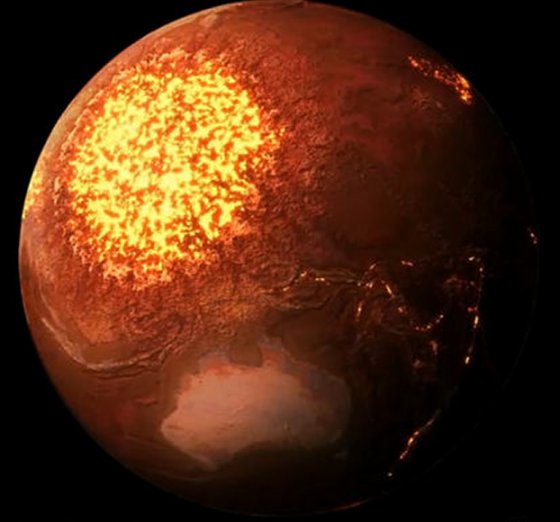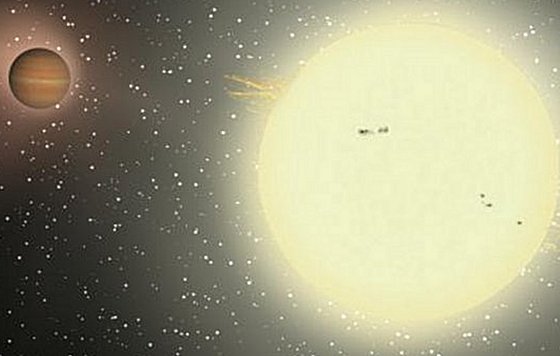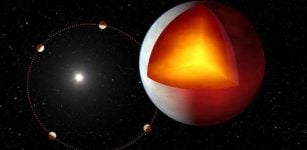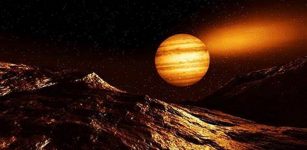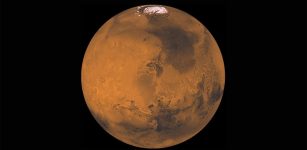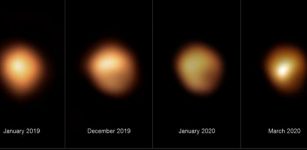10 Most Bizarre And Record Breaking Alien Worlds
MessageToEagle.com – Our Universe is full of exotic alien planets. Most of these worlds bear very little resemblance to Earth and some of them are extremely bizarre. In this top list we present 10 of the most record breaking and bizarre alien worlds detected so far.
1. CoRoT-7b– an alien world that contributes to the vision of hell
“CoRoT-7b is almost 60 times closer to its star than Earth, so the star appears almost 360 times larger than the sun does in our sky.
The planet’s surface experiences extreme heating that may reach 3,600 degrees Fahrenheit on the daylight side. CoRoT-7b’s size (70 percent larger than Earth) and mass (4.8 times Earth’s) indicate that the world is probably made of rocky materials.
“But with such a high dayside temperature, any rocky surface facing the star must be molten, and the planet cannot retain anything more than a tenuous atmosphere, even one of vaporized rock,” said Brian Jackson at NASA’s Goddard Space Flight Center in Greenbelt, Md. Solar heating may have already cooked off several Earth masses of material from CoRoT-7b.
CoRoT-7b takes just 20.4 hours to circle its sun-like star, located 480 light-years away in the constellation Monoceros.
2. Epsilon Eridani b – the nearest alien world outside our solar system
Epsilon Eridani b is the closest planet outside the solar system approximately 10 light years away. Officially announced as discovered in 2000 its existence was confirmed by the Hubble space telescope in 2006.
It is about 1.5 times the mass of Jupiter.
The planet orbits the nearby Sun-like star Epsilon Eridani, located 10.5 light-years from Earth in the constellation Eridanus. The planet’s orbit is inclined 30 degrees to Earth, the same angle at which the star’s disk is tilted. It orbits its star every 6.9 years.
Is Epsilon Eridani b abode of life as we know it? No.
Epsilon Eridani b is a gas giant–a fact that rules it out as a place for finding life as we know it. The behemoth’s atmosphere is probably a lot like Jupiter’s–mostly hydrogen and helium, with trace amounts of methane, ammonia, and other gases. The planet likely has no solid surface. Astronomers suspect its deep, turbulent atmosphere has huge convection cells that alternately cook and freeze any organic material caught up in their vertical motions.
3. TrES-4b – the biggest alien planet found so far
The planet is about 1.7 times the size of Jupiter and defies current scientific explanation.
“TrES-4 appears to be something of a theoretical problem,” said Edward Dunham, Lowell Observatory instrument scientist.
“It is larger relative to its mass than current models of superheated giant planets can presently explain.”
TrES-4b was discovered by the Trans-Atlantic Exoplanet Survey in 2006. The object is located in the constellation Hercules.
The planet’s home star, a member of a binary system, is bigger and hotter than the Sun, and is about ten times larger than the planet.
Astronomers speculate that the large size and low density of TrES-4 may cause a small fraction of its outer atmosphere to escape from the planet’s gravitational pull and form an envelope, or a comet-like tail around the planet.
“The planet’s size is much larger than predicted for its mass,” said Georgi Mandushev of Lowell Observatory.
“The alien planet is about as dense as balsa wood or cork.”
The unusually large size of the planet has something to do with extreme heat. The planet is only 4.5 million miles from its parent star, and it orbits in about three days, compared to Jupiter’s 12-year revolution.
TrES-4 is superheated to about 2,300 degrees Fahrenheit (1,260 degrees Celsius)!
4. HD 188753 Ab – alien world with triple sunsets
The new planet is the first known to reside in a classic triple-star system. The masses of the three stars in HD 188753 system range from two-thirds to about the same mass as our Sun.
The planet – a hot, jupiter-sized planet which is slightly more massive than Jupiter – is orbiting in triple star system HD 188753, only 149 light-years away in the constellation Cygnus (The Swan).
The planet whips every 3.3 days around a star that is circled every 25.7 years by a pirouetting pair of stars locked in a 156-day orbit.
5. OGLE-2005-BLG-390L b – coldest and farthest planet of 5.5 Earth masses
This icy exoplanet is more Earth-like than any other planet found so far. It’s only about 5 times as massive as the Earth, circles its parent star in about 10 years. OGLE-2005-BLG-390L b is the least massive exoplanet around an ordinary star detected so far and also the coolest. It lies about 390 million kilometres from its star: if it were inside our Solar System, the planet would sit between Mars and Jupiter.
Unfortunately, this Earth-like body probably isn’t crawling with life, at least with life – as we know it. Its dwarf star is so dim that the surface temperature of this planet is thought to be about – 220 °C.
6. 55 Cancri e – most alien world we can only imagine
The alien planet – twice the size of Earth – and named “55 Cancri e” – is 26 times closer to its parent star than Mercury is to the Sun.
The temperature on the surface of 55 Cancri e is estimated to be as high as 2,700 degrees Celsius. Recently it has been discovered thatthis alien world visible to the naked eye in the constellation of Cancer, is composed of carbon, iron, silicon and carbide.
It’s very hot on with temperatures on its surface as high as 3,900 degrees Fahrenheit (1,648 Celsius).
Most probably, the planet’s surface is covered in graphite and diamond rather than water and granite, according to astronomers.
7. WASP-12b – the doomed planet which is being eaten by its parent star
WASP-12b – often called “the bling planet” – can be found in the Auriga constellation. WASP-12b is located relatively close to its mother star at only 1/44th of the distance the Earth stands from the Sun. It is a mere 2.1 million miles (3.4 million km) from the solar surface, while the Earth is a comfortable 93 million miles (150 million km).
The planet – 40 percent more massive than Jupiter – makes a full orbit in a little over one Earth day, meaning that a day on Earth is a year on WASP-12b.
Due to this incredibly close proximity, the atmosphere has begun to swell, causing the planet to distort into an egg-like shape. The star has started to tear away at it through stellar winds, ripping over 6 billion metric tons of mass from the planet per second. All of that mass is lost to space forever.
The planet, called WASP-12b, is so close to its sunlike star that it is superheated to nearly 2,800 degrees Fahrenheit and stretched into a football shape by enormous tidal forces.
8. SWEEPS-10 – the fastest and the hottest one
SWEEPS-10 has the shortest orbital period (835 times shorter than Earth’s) and swings around its star in 10 hours. Astronomers say that if you were born in 2000, you would already be 10,855 years old.
Located only 740,000 miles from its star, the planet is among the hottest ever detected. It has an estimated temperature of approximately 3,000 degrees Fahrenheit!
Only the star’s low temperature allows the planet to survive so near to the star.
“This star-hugging planet must be at least 1.6 times the mass of Jupiter, otherwise the star’s gravitational muscle would pull it apart,” according to SWEEPS team member Mario Livio.
9. COROT-exo-3b – a planet denser than lead
This planet orbits a star larger, brighter and hotter than our Sun – in just over 4 days! It has about the same diameter of Jupiter, but has 21.6 times Jupiter’s mass. That makes it denser than lead.
Located in the constellation Aquila, COROT-exo-3b takes only 4 days and 6 hours to orbit its parent star, which is slightly larger than the Sun. The surface gravity is very high, over 50 times the gravity felt at the surface of the Earth.
The mystery is how such a massive object formed so close to its parent.
10. TrES-2b – black planet – darkest ever seen alien planet
It’s truly an alien world. Why is this planet so dark? Reasons for TrES-2b’s darkness remain unknown!
Orbiting only about three million miles out from its star, the Jupiter-size gas giant planet, dubbed TrES-2b, is heated by the star’s intense light to 1,800 degrees Fahrenheit (980 degrees Celsius) – much too hot for ammonia clouds.
See also:
10 Great Space Images: Quizz: How Well Do You Know Your Space Photos?
5 Beautiful Nebulae – Among The Most Amazing Astronomical Objects In The Night Sky
10 Astronomy Facts: Remarkable, Fascinating And Puzzling
Yet the apparently inky world appears to reflect almost none of the starlight that shines on it.
Being less reflective than coal or even the blackest acrylic paint—this makes it by far the darkest planet ever discovered,” according to a study author David Kipping, an astronomer at the Harvard-Smithsonian Center for Astrophysics in Cambridge, Massachusetts.
TrES-2b orbits its star at a distance of only three million miles. The planet’s exotic atmosphere contains light-absorbing chemicals like vaporized sodium and potassium, or gaseous titanium oxide.
Yet none of these chemicals fully explain the extreme blackness of TrES-2b. It’s not clear what is responsible for making this planet so extraordinarily dark.
Copyright © MessageToEagle.com All rights reserved. This material may not be published, broadcast, rewritten or redistributed in whole or part without the express written permission of MessageToEagle.com.
Expand for references
